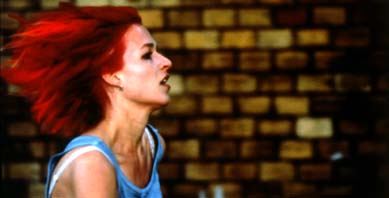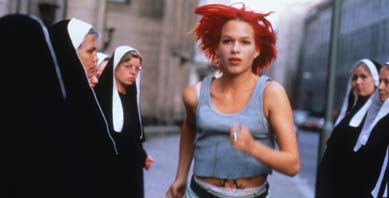Run, Lola, Run - The Career of a Film

In order to try and set the right mood, one month before shooting was to begin, Tom Tykwer wrote a letter addressed to both actors and other team members. Film making, he pointed out, is often like an obstacle race. "But sometimes it happens that films come out, which, despite breaking the apparent rules regarding story telling, markets and money, are enthralling, clever, emotional and intelligent. Lets make one of those."
(Film) History In The Making
He made it. A stroke of genius: from the dramatical aspect an experimental film; in its making, a firework for cineastes; in the cinemas a mega-hit, which even one year after its premiere still brought in the crowds and changed the German film landscape. The 20th of August, 1998 has come to mark an important date: "Lola rennt" ("Run, Lola, Run") is shown across Germany with 208 film copies and is seen in the first week by an audience of 360,000 movie-goers, reaching third place in the charts (after "Lethal Weapon 4" and "X Files: The Film"). For film industry insiders, another key figure was even more decisive: the film copy average – 1,734 viewers per copy (in comparison to "Lethal Weapon 4" with 649 copies and 689 viewers and "X Files" with 833 copies and merely 717 viewers). In the second week "Lola rennt" took second place, and in the third week reached top of the charts: first place with an audience of almost a million. Indeed, months afterwards, this unconventional film stayed at the top range of the German movie charts, successfully contending with American blockbusters and German sweetheart comedies. More than 2.5 million movie-goers have seen the film so far, and it is now available on video and DVD.
Universally Unconventional
After the sensation, everything becomes an anecdote, like when the film rating "over 12 years of age" had to be fought for because of the alleged "presentation of violence". Or that no record company wanted to release the soundtrack, and so just four weeks before the film was to be released, a new label had to be found – and then, with 250,000 singles sold, "Wish", with Franka Potente and Thomas D., got a gold record (the CD sold around 100,000 times). Or that hair product company Wella rejected the cross-promotion and thereby lost a unique opportunity, while another "red" product made good use of Lola: six million Kraft Ketchup bottles were graced by the image of the red-haired speed queen. That the Majors telephoned the distributor Prokino, but couldn't believe the figures, which also astonished the people at Munich Headquarters: Although the distribution experts were more optimistic after the first text screenings (and increased the number of film copies), the new benchmark was still modestly set by "Trainspotting" with a million viewers. Covering the release, the newspaper "Die Welt" wrote: ""Lola rennt" – dare we say – is going to make Tykwer known throughout Germany." Then the film went around the world. First is was screened at festivals – Montreal, Venice, Toronto, Sundance, Seattle, San Francisco – where its success was already becoming visible, and then it was sold right across numerous markets. "Lola rennt" speaks a universal film language, one which we would normally expect only from Hollywood productions.
The German Marvel

Amazing news out of L.A.: German film draws Hollywood celebrities into the movie theater. Winona Ryder, Julia Roberts, James Cameron saw "Run, Lola, Run" in the Nuart Theater, reported the "Los Angeles Times". A low-budget production, screened with subtitles, is celebrated as a cinematic marvel. The trade paper "Entertainment Weekly" gives it the top grade A: "Fourty years after Godard’s revolutionary début, Tykwer has made a truly breathless film." Throughout the country, "Run, Lola, Run" has been prominently featured by the American press. Franka Potente appears on the cover of "Time Out," while the independent film magazine "Filmmaker" dedicates a cover story to Tom Tykwer. Ranging from the "Boston Globe Review" to the "Seattle Times," from "Hollywood Reporter" to the prestigious "Wall Street Journal": without exception, the film is given a three and a half to four star rating by critics. The film had only one flaw – the MPAA-Rating "R", "Restricted because of some violence and language." Given such rave reviews, the typical American Box-office effect followed: around 500,000 Dollars brought in two weeks, number 20 in the charts, number 8 in the Manhattan Top Ten. The soundtrack climbed to number 5 in the Billboard Electronic Albumcharts.
Hip and light – Lola conquers Hollywood
The film was first released in four movie theaters in New York, among them the Angelica Center in Soho. The New Yorkers were well prepared, for six months earlier, "Run, Lola, Run” had been screened in the "New Directors / New Films" series organized jointly by the Lincoln Center and Museum of Modern Art, where it received enthusiastic critical acclaim. Writing in the ”New York Times,” Janet Maslin heralded its intelligence and cunningness, and celebrated its breathtaking forward driving power and innovative potential. A true hymn of praise: "Tykwer joins together visual tricks that have the tempo of a speed of light, inexhaustible changing styles and the limitless possibilities of interactive narration." Its reputation raced ahead. "Run, Lola, Run" won awards at the Sundance Festival as well as at the San Francisco and Seattle film festivals. Sony Pictures Classics consciously brought out the film on a small scale in order to avoid having half empty movie theaters. Not until the fourth week were the number of film copies increased, with screenings first in 70, and later in 172 cinemas. It was the right strategy – for the US distributor knew, according to Michael Barker of Sony, that for a German film, even if it is ”hip and light,” there remain difficult obstacles to overcome: they can only be successfully avoided by attempting to jump over them. With a blockbuster strategy, this would have definitely failed.
The Germans are coming
This experience had already been made in France a few months earlier. The French distributor ARP Selection brought out "Cours, Lola, cours" in a dubbed version with 165 film copies and lots of promotion at the cinemas. The result was a disaster with only 45,000 viewers in the starting week. That meant a meager 270 viewers per copy. ARP chief Philippe Kaempf played down the German origin of the film, giving it instead a more international image. It didn’t help: After the flop, the film magazine "Le Film français" concluded that "The public seems to be allergic to today’s German cinema.” In comparison, the question about "How German Is It?" was rarely raised in the USA. Its theme was recognized as universal (and the appearance of the "young Berlin Hipster named Lola" reminded some critics of the masculine look of drawings typical of the comic artist Robert Crumb). In the USA, "Run, Lola, Run" grossed seven million Dollars (over there the number of Dollars count, not the number of viewers). This is the second best results ever to be attained by a film in the German language, with only "Das Boot" achieving higher figures in 1982. Tom Tykwer's film is breaking new ground for young German cinema. American critics are realizing astonishingly: "The Germans are coming."
Quotations from Michael Töteberg (Ed.): "Szenenwechsel. Momentaufnahmen des jungen deutschen Films". Reinbek bei Hamburg: Rowohlt, 1999